Decluttered.
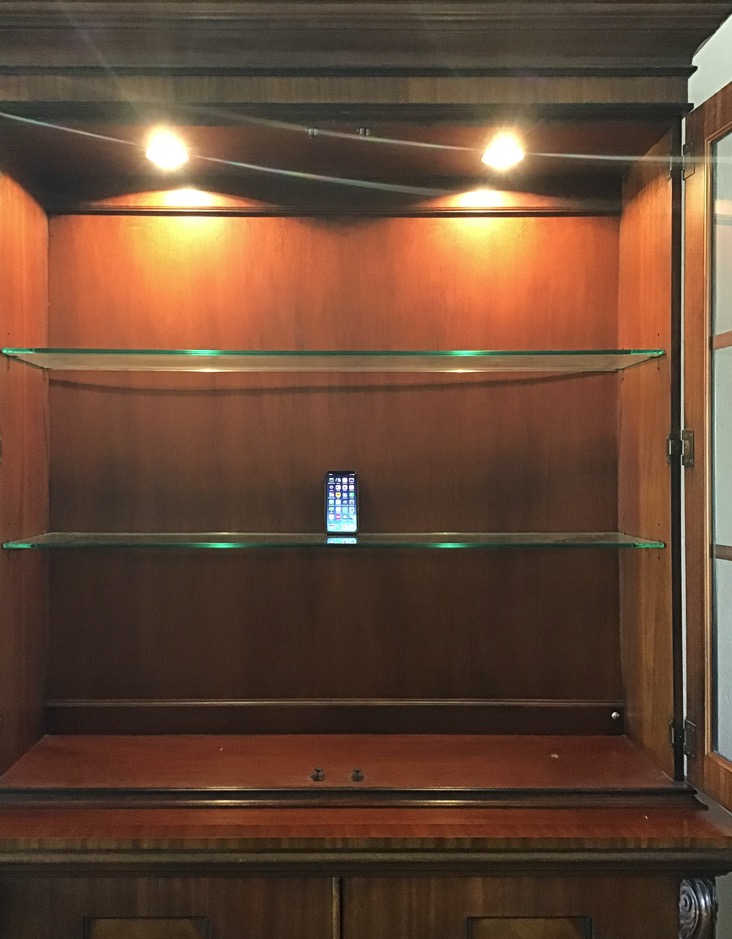
Snapped on my iPad.
Decluttered.

Snapped on my iPad.
His greatest strategic decision is little recognized.
Samsung cell phones are made by thieves.
Samsung steals the design, UI, even the packaging from Apple. The Android OS which these devices run is made by America’s greatest thief, Google. Sure, the fine print says you agreed to it, and consequently your data are stolen and resold to anyone who cares to pay. And because thieves do not care for the welfare of their victims, Android sees to it that its infinitely penetrable code is open to bad guys to further abscond with your life and secrets. If you use Android, that’s a tacit admission that your data is worth to you exactly what Google paid you for it.
Daniel Eran Dilger has been writing technical articles for Apple Insider for as long as I remember. Invariably thoroughly researched, his latest series chronicles Jobs’s greatest stroke of genius, one which directly addresses these thieves and their nefarious ways.
Sure, we all know how the iPod took a clunky concept and turned it into a supremely elegant rendition, accompanied by one of the greatest advertising slogans ever:
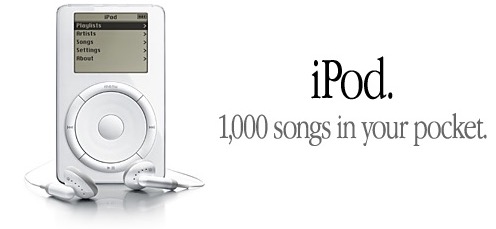
The iPod followed the 1998 iMac and between them the products turned around a failing company. The string of hits – the Apple II, the Mackintosh, the iMac, the iPod, and the greatest of all – the iPhone – rightly saw Jobs branded as the greatest visionary since Thomas Edison. Unlike Edison, Jobs never created completely new technologies such as the light bulb, the phonograph, the movie camera. Rather, he looked at what the market had to offer and improved those offerings with quantum leaps in design and user interfaces. Obsessing over the smallest detail, he reminds us that “don’t sweat the small stuff” is an expression dreamt up by those who have no attention span or standards.
When the iPhone was released on June 29, 2007 the army of buyers had already been astonished by the user interface, displayed by Jobs in his earlier presentation (January 9, 2007), with such seemingly magical features as scrolling, with that little bounce when the end of the list was reached. I recall gasping when Jobs first showed that off. As one of his friends put it when discussing his presentation of the first iPhone: “You had me at scrolling”. It was fun, it was new and it was breathtaking UI design. Samsung immediately stole that for it’s better cell phones (most of their money is made on low end devices for the third world). They had already long been stealing from anyone in sight, right down to emulating the easily removed cellophane in which Apple’s beautifully packaged products were ensconced. Jobs finally said “Enough!” and applied to make the scrolling/bounce feature trademarked. He lost, the judge denying his claim stating that it failed on grounds of obviousness ….
So in 2008, Jobs took another tack. He decided to bring the design of mobile CPUs in house, meaning that the ARM designs would hereafter be exclusive to Apple. The first such CPU was the A4:
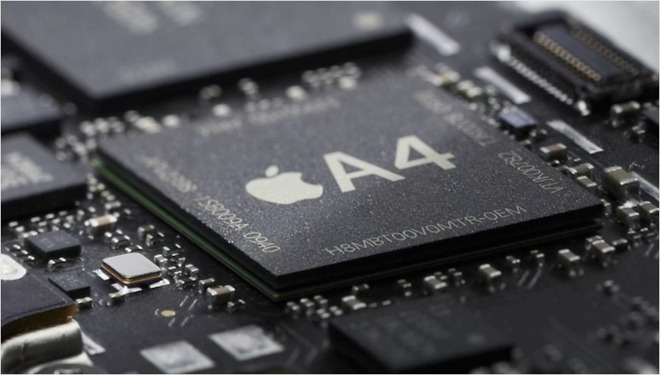
As Dilger explains, that CPU was first installed in 2010 and within 6 years was the brain in over one billion Apple devices. Moving away from generic Samsung chips, the A4 was installed in the iPad, iPhone 4, the fourth generation iPod touch, and the second generation Apple TV. The decision to bring CPU design in house was Jobs’s greatest stroke of genius and we are now seeing the fruit of that decision.
The most astonishing outcome of this decision is the latest A13 CPU, containing all of 8.5 billion transistors, we are told, spaced just 7 nanometers apart. It’s what makes computational photography possible in the game changing iPhone 11 and 11 Pro and will see the speedy demise of most mainstream digital camera manufacturers.
The day of the big sensor is done, with each sensor’s area in the iPhone 11 being just 5% (five percent!) of that in the gargantuan DSLR’s full frame carcass, yet delivering comparable performance. Along with the demise of big sensors and the bodies which house them, we will see the simultaneous demise of vast catalogs of enormous – and enormously costly – lenses, some claiming apertures as fast as f/0.95. Why? Because the f/2 or so apertures in the iPhone’s lenses are the functional equivalent of f/0.2 when you add in computational photography and such seemingly magical technologies as Night Mode. The traditional meaning of ‘aperture’, as in “f/1.4 is faster than f/2.8”, no longer makes sense.
Dilger tells us that the major competing CPU, used by Samsung and Android, is the Qualcomm Snapdragon which is already two generations slower and requires larger batteries (that’s a ‘feature’, in Samsung ads) to satisfy its electrical thirst. Despite two years’ development, Qualcomm has been unable to improve the performance of its CPU.

Meanwhile, Samsung has abandoned its efforts to steal Apple’s FaceID security technology, unable to clone it, while Google’s Pixel has done a poor job of stealing Apple’s older fingerprint recognition. Stick a protective plastic sheet on your purloined Pixel’s screen and any fingerprint in the world will open the phone. That seems appropriate. What, after all, would you expect from the world’s premier thieves? At the same time Apple has been undertaking a multiple year effort to rid itself of all Samsung content in its devices. With friends like that, who needs enemies?
Apple has had three major CPU makers for its desktops and laptops. The Apple II used the Motorola 68000 family, the Mac switched to IBM’s more powerful but hot running PowerPC CPUs and current hardware uses Intel chips. As the saying goes on Wall Street, “If you want loyalty, get a dog“.
Jobs’s decision to bring mobile CPU design in house will eventually see Apple’s desktops and laptops move to the ‘A’ series CPUs used in iPhones and iPads, allowing Apple to sidestep Intel’s interminable delivery delays and have a far less costly CPU in its devices. And performance will only improve.
The A13 is now approaching the fastest Intel CPUs in performance, and we can expect the same stellar gains in battery life in the MacBook as the iPhone 11 sees over its predecessor iPhones. Apple already uses A series chips to control the touch bar in its MacBook Pro. The writing is on the wall.
Dilger’s series of exhaustively researched articles is recommended to those who want a deep look inside the genius of Steve Jobs.
iPhone 11 Pro image, standard lens.
Not a right angle in sight.

My local library is one of those wildly abstract and severe designs which denies the existence of the ninety degree angle. This sort of architecture is fodder for the camera, as the above image discloses.
One of the complaints I have seen aimed at the ultrawide optic in the iPhone 11 and 11 Pro is that it is fixed focus. Such opinions are expressed by those with no training in the physics of photography. A 1.54mm focal length lens (13mm FFE) will render everything sharp all the time, as I illustrate here. There is no need for focusing. And if you want to change depth of field, Focos awaits. The other complaint is that saving the image in RAW format is not possible. Only compressed JPG is available. What this opinion denies is the extent to which computational photography and Apple’s always-on SmartHDR technology obviates the need for RAW. (RAW is available in some camera apps like Halide, not in the stock Camera app). Finally the third complaint – excessive lens distortion and vignetting – is justified, but easily resolved with one click in LR or PS or ACR using my lens correction profile. Apple’s claim that they left distortions uncorrected for the UWA lens to emphasize its ‘wideness’ is so much rot. They clearly rushed the product to market along with a disastrous series of iOS 13.x releases, each replete with bugs.
It is the small file sizes of JPGs for the UWA – and indeed JPG is standard for all three lenses – that is one of the unsung secrets of the camera’s design. As the data for the above image disclose, the RAW image is some 12mp (3024 x 4032 = 12.19 mp), whereas the JPG is a mere 2.88 mp. Now a file from your enormous Nikon D850 with its 50mp sensor and no less gargantuan optics will come in at some 150mp when converted to TIFF or PSD, which is what LR or PS has to do before you apply any processing corrections.
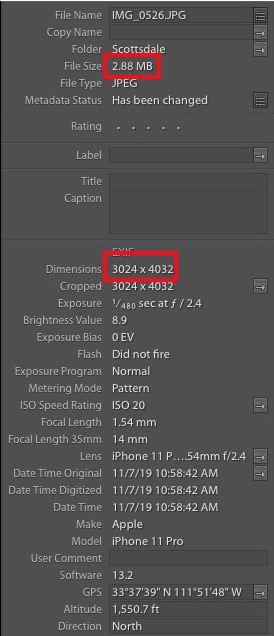
And by contrast, so sophisticated is SmartHDR in the iPhone that those corrections are rarely called for. So suddenly LR performs once more like the spring chicken it once was, loading those 3mp files in a trice and creating full size previews in like time, whereas your D850 image dictates ever larger capital outlays on more storage, faster storage and improved GPUs. Why, process just seven of those images and there goes a gigabyte of storage …. And while you are processing all of those bytes, I have crafted a blog entry, written a suitably inflammatory narrative and am out on the street searching out new subjects for my camera. Plus, you are $5,000+ out of pocket and your shoulder is sore. I suffer from neither affliction.
Not half bad.
To check how the iPhone’s Normal lens (the 25mm 1x option) compares with a full frame DSLR, I dusted off my Nikon D700, a 12mp FF digital body with a sensor renowned for its low noise. The closest fixed focal length lens in my rapidly dwindling Nikkor collection is the superb 20mm f/3.5 UD Nikkor, a lens which comfortably outperforms its three successors which came in compact variants with f/4, f/3.5 and f/2.8 maximum apertures. Dwindling? I do not collect gear and will have little if any use for these dated behemoths after buying the iPhone 11 Pro.
I then photographed one of my bookshelves with the iPhone and with the Nikkor, comparing the two in Lightroom. In the comparison image below, the iPhone image is straight out of camera. The Nikon’s had to have contrast increased but is otherwise also SOOC. The iPhone image is JPEG, whereas the Nikon image is RAW.

The images below are 1:1 enlargements – the pixel peeper’s favorite which has sold a lot of ridiculously large sensors to those who have no earthly need for them. Each image is from the center of the sensor. We are talking 30“ x 40“ prints here.
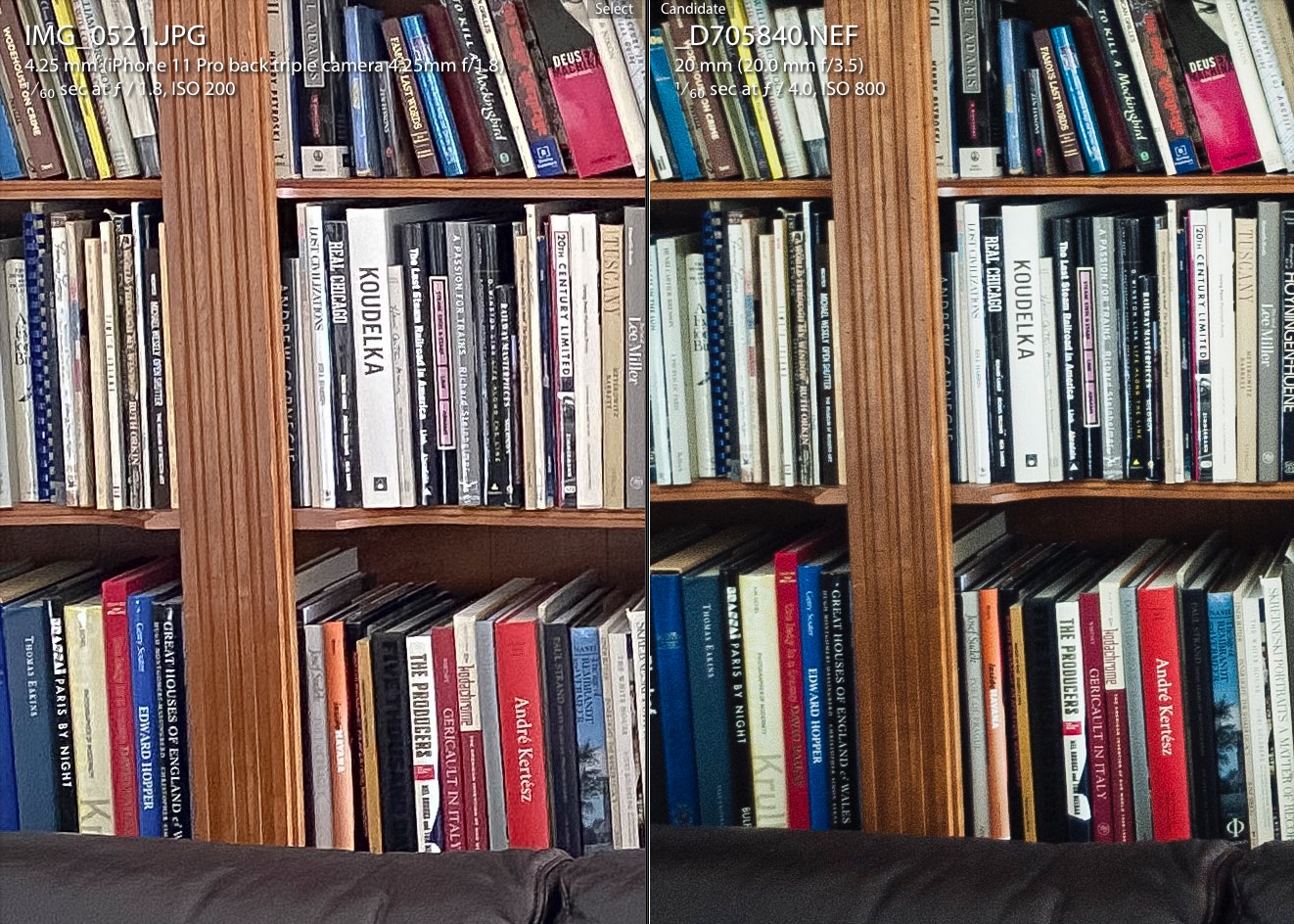

I would guess that the iPhone image is using Deep Fusion computational photography, but frankly all I care about is the result, not the road traveled to get there. You be the judge.
Not that obvious.
With the introduction of iOS 13.2 Apple has enabled Deep Fusion for the cameras in the iPhone 11 and 11 Pro. For an explanation of how this works click here. Note that Deep Fusion does not work with the ultrawide lens; it’s limited to the normal and telephoto. You must also turn off “Photo capture outside the frame” in Camera Settings. Finally, Deep Fusion does not work in burst mode and requires a current top of the line iPhone, meaning the 11 or 11 Pro.
By sampling and combining the best parts of multiple images Deep Fusion claims to further improve the already stellar results from the iPhone 11’s camera. It’s not easy to test, however, as it only kicks in with moderately lit subjects and there’s no indication that it’s working.
To compare results, I took one indoor image using iOS 13.1, downloaded the update, and took a second image with iOS 13.2, the one with Deep Fusion.
Here’s the original:

Before and after exposures and ISOs were identical. No processing was applied in Lightroom.
Here is the center of the image magnified to a print size of 60″ x 80″:
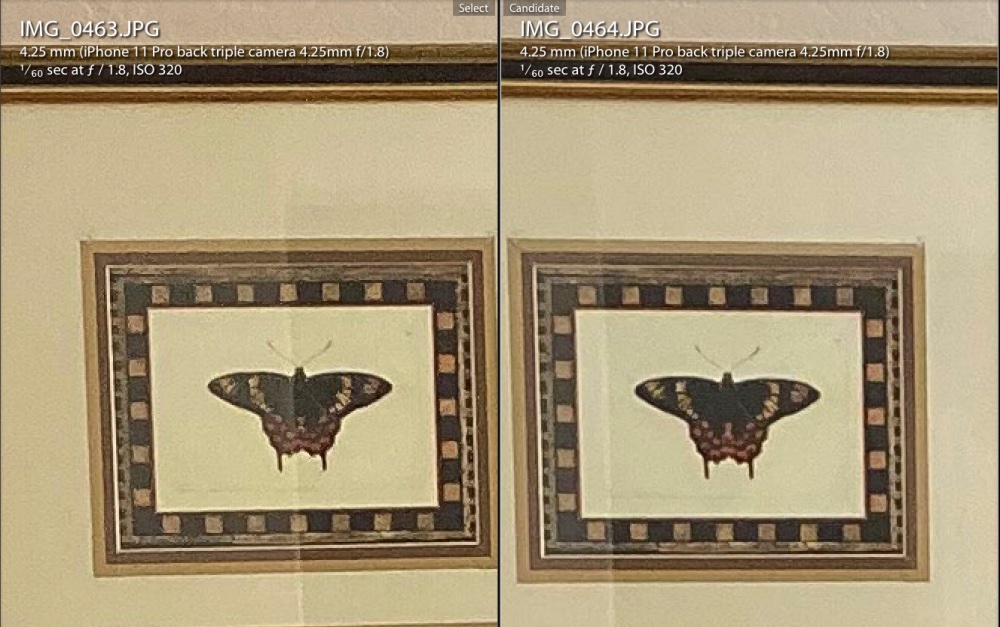
There is just a little more detail (and less aggressive sharpening by the iPhone) in the butterfly’s wings in the Deep Fusion version, less smearing and slightly lower contrast.
Now let’s take a look at the shadows nearer the edge:
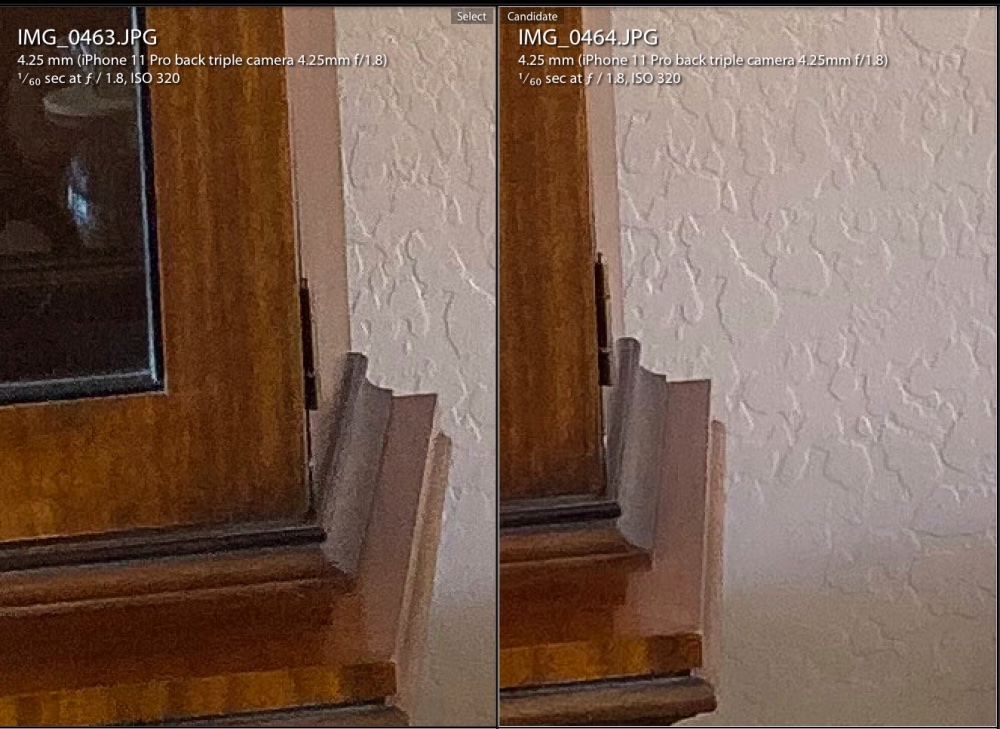
Again there is a very small gain in definition but a significant reduction in grain and less smearing of the detail. Contrast in the Deep Fusion version is again lower.
So does Deep Fusion improve things? Yes. Is that improvement really significant? No.
But the above – these are enormous enlargements – confirm that the days of gargantuan sensors are numbered. A pinhead sized sensor combining multiple images shows barely any grain and more definition than any photographer looking at a 30″ display will ever need. Unlike on your DSLR, that sensor is dust and waterproof. As for web publication, it bears repeating: No one needs more than 3mp.